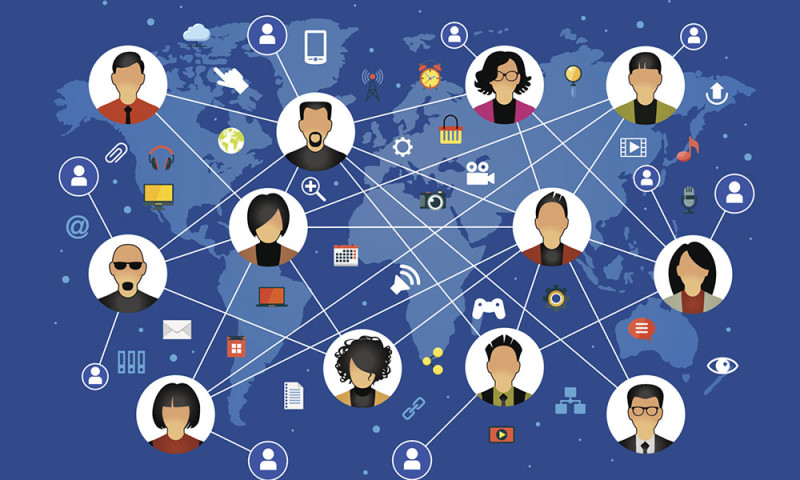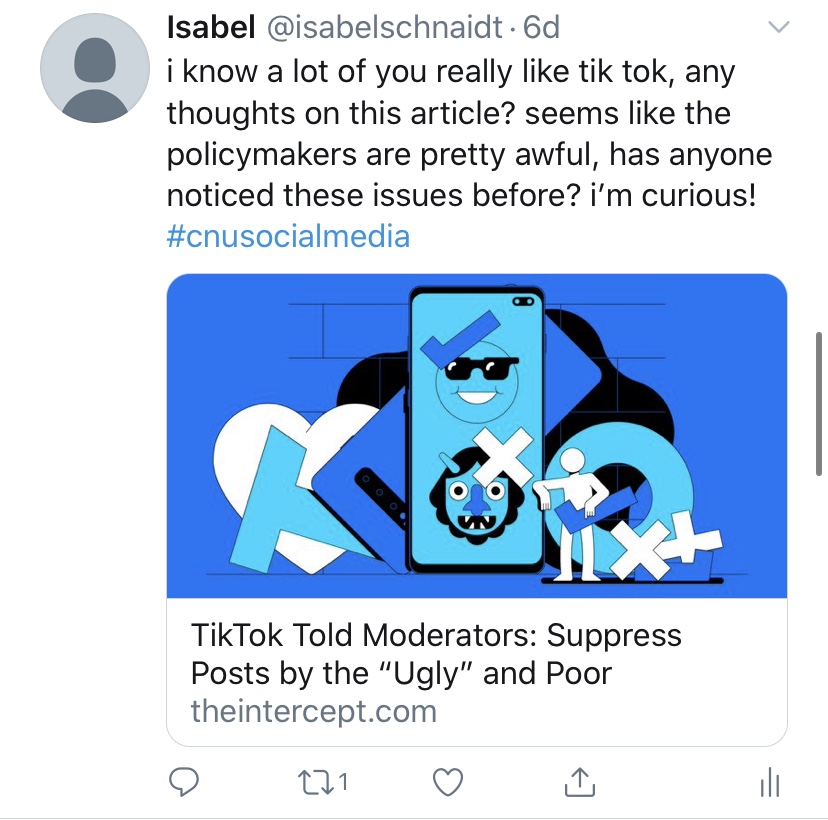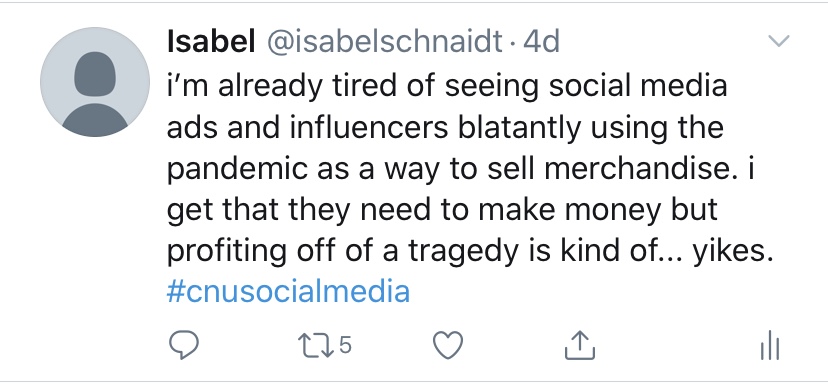On the first day of class, when we were told that we’d have to tweet daily, I admit that the thought filled me with dread. At the time, the only tweets that I had ever written were for internships, which was completely different, since they were never my own personal thoughts and opinions. I had no idea how I was going to manage to go from clueless about Twitter to tweeting daily. As I look back on my experience, however, I realize that while I struggled at times, it was easier and more rewarding than I ever thought it would be.
 |
| Initially, I was terrified of Twitter |
Challenges
While daily tweeting wasn’t as intimidating as I thought it would be, I definitely still struggled at times. The main issue that I encountered was exactly what I expected: there were days where I had no idea what to tweet about. I wanted to make sure that I was actually contributing something valuable or posing a question that people would have opinions about. Because of this, there were many days where I spent longer than I’m willing to admit trying to think of things to tweet. I think that I got slightly better as I got more practice with tweeting, but I continued to struggle to some degree for the whole semester.
Though I predicted that my lack of ideas would be difficult, there was also a one-time occurrence that presented an unexpected challenge. At the end of January, a
random Twitter user replied to
my tweet about The Circle in a way that simultaneously bewildered and annoyed me. I posted some light criticism questioning why
Shubham would audition to be on The Circle if he hated social media so much. In the response I got, as pictured below, @TheSavageNorth claimed that Shubham was randomly put on the show through a lottery, seeming to imply that reality TV contestants are randomly selected with no audition process.
 |
| Pictured is the aforementioned tweet, which I still don't entirely understand. |
I honestly didn’t know what to do about this response. I was worried that I misinterpreted it, but I don’t see what else he could have meant. Calling me an idiot after showing that he had no idea how reality TV works was a move that was both infuriating and hilarious, and I was very tempted to respond to him. I knew that I could try to gently correct him by
linking to the casting applications for The Circle, which would ideally help him see that he was wrong.
However, a couple of things stopped me from replying. The first thing that came to mind was our class discussion on #GamerGate, where online harassment can have particularly scary impacts for women,
like Brianna Wu. Since my real name and the school I go to are attached to my Twitter account, I knew that if this guy was anything like the #GamerGate men, it could be bad for me. So while I’m sure that my offhand comment wasn’t enough to actually put me in danger, I figured that it’s always better to be on the safe side, even if that meant not correcting his misconceptions.
Based on the way he tweets, I also figured that a conversation wouldn’t be worth it. His response reminded me of masculine online rhetoric, which is defined by self-promotion, rhetorical coercion, and adversality (Hodapp, 2017, p. 43). @TheSavageNorth particularly demonstrated rhetorical coercion and adversarial put-downs when speaking to me. This kind of rhetoric creates an environment “hostile to constructive conversation, exchange, critical thinking, and meaningful dialogue,” so I knew that he wouldn’t seriously listen to me or express a willingness to be corrected (Hodapp, 2017, p. 44). The unfortunate side effect of my restraint is that his tactic succeeded in silencing me, which is often one of the goals of masculine rhetoric. While I wasn’t actually offended, I hope that this didn’t embolden him to continue replying to strangers in the same way in the future.
 |
| Even just looking at his profile, I knew that a constructive conversation wouldn't happen, so I was content to send screenshots to friends and laugh at him in private. Contrary to his wildly condescending bio, he ended up providing me with a lot of entertainment (as his expense). |
Luckily, the response I got was a one-time occurrence and not at all serious, but it did demonstrate how easy it is to get into arguments online, even with complete strangers. I think that after this incident, I subconsciously began to censor myself a bit to avoid confrontations like this in the future, which I will elaborate more on when I talk about some shortcomings. It also highlighted the lack of privacy that a public Twitter account has, since I didn’t even use a common hashtag, yet a stranger still found my tweet.
Enjoyment
Despite the challenges I faced, both expected and unexpected, there were also several aspects of daily tweeting that I enjoyed. The main thing that I really appreciated was hearing the opinions of my classmates. Tweeting provided a way for the people who might not normally speak up in class to speak their minds in a different format. It also allowed people to post the thoughts that come to them throughout the day, instead of just in class, meaning there was a lot of variety in the content. Through Twitter, I heard more from my classmates in this class than any other, which was particularly nice after we moved to online classes.
One particular thing that I loved to read about was when my classmates were able to relate class concepts to current events, whether that be the actions of CNU, the pandemic, or
trending Netflix shows. I liked seeing the connections that I never would have been able to make myself, and I think that it helped to solidify the real-life applications of a lot of the class material in my mind in a way that doesn’t happen in other classes.
 |
| Twitter was a good way for me to keep up with classmates when physically separated. |
And while I did struggle with figuring out what to tweet about, I also enjoyed the ability to express my thoughts. I surprised me that there were times where I wanted to put some opinions forth or ask the class some questions. In my first blog post, I referenced my own uses and gratifications from social media, and I mentioned that I never used social media to express my opinions, but only for things like entertainment, relaxation, and passing time (Whiting & Williams, 2013, p. 366). Contrary to this initial finding, as the semester came to a close, I realized that I was getting some enjoyment out of being able to express myself, which was entirely unexpected.
Online Communities
One of the big things that I learned about creating and maintaining an online community is the importance of hashtags. Even though we were required to follow each other for this class, the
#cnusocialmedia hashtag was an important way to organize our tweets and keep us unified (and would have been even more important if we didn’t follow each other). Hashtags don’t have fixed and stable boundaries that entire online communities neatly fit into (Bonilla & Rosa, 2015, p. 7). However, they are extremely useful for bringing people together and maintaining an online community, even if they don’t entirely encompass them, as demonstrated through #cnusocialmedia.
 |
| I was surprised to learn how important hashtags are, but I also know that they are normally more complex than what our class activity could account for. |
Through our class tweets, I also learned about the importance of interactivity for maintaining an online community. When people just independently tweet about the same topic without interacting with each other, it feels less like a community and more like separate people monologuing about the same thing. However, by actually interacting with and responding to each other, people can build more of a sense of community and togetherness. This was definitely evident in the way our class tweeted. On the days when we tweeted more independently, the contents of the hashtag seemed like some loosely connected but separate thoughts. But, when we actually interacted with each other, it was more unified and engaging.
I also realized that while social media is an asynchronous medium, live events are still extremely important for building and maintaining communities online. This was brought to my attention on the day that we live-tweeted an episode of Scandal, because it definitely felt like we were stronger as an online community at that point more than any other. The feelings of “shared temporality” while live-tweeting make people feel like they are part of a community, as it provides engagement in “real time” activities (Bonilla & Rosa, 2015, p. 7). This shows that while social media can and does often stand on its own, having a live event to rally around can be extremely important. This strengthens communities who may live far away from each other, since they all get the same feelings of shared experiences and participation. Additionally, it helps me to understand why
live-tweeting television is such a common practice, because it really heightened the experience of watching the show. I also understood why television producers often aim to promote live-tweeting and building “brand communities” around their shows, because these shared experiences likely build intense brand loyalty (Casella, 2015, p. 4).
 |
| While we only used social media within our class, Twitter can be used to build online communities across the world. |
Shortcomings
I think that my main shortcoming is that I didn’t respond enough to my classmates’ tweets. In fact, I think that as a class, we didn’t interact enough to build a community as strong as we could have otherwise. I would often prefer to pose questions rather than answer them, and I noticed that a lot of other people did as well. Because of this, many questions went unanswered, and people retweeted them without comment instead of answering. I honestly don’t know why this happened on such a large scale, but I know that personally I often forgot that responding to people was something that counted for credit, so I would primarily write original tweets. I think that a preference for original tweets isn’t a bad thing by itself, but since the vast majority of the class shared this preference, it meant that we had relatively low interactivity and weren’t necessarily strong as a “community.”
Another way that I think I fell short was by hedging my opinions in tweets by toning down my stronger views when I knew they would be controversial. I did this twice in the last week of tweeting, as pictured below, though I know I did it many times before, as well. This was an example of self-censorship, where I avoided more controversial topics to manage impressions with my readers (Marwick & boyd, 2010, p. 125). Part of this was because of the negative encounter I had after tweeting about The Circle, but I was definitely more focused on the impressions I was giving my classmates. Since I knew that my primary audience were others in this class, I knew a lot about them and didn’t want to offend any of them. That means that I self-censored my tweets to manage impressions and avoid hurting feelings, even when I knew that my honest opinions might have incited more passionate discussions.
 |
| I know that a lot of my classmates like TikTok, so instead of outright condemning the actions of the company, I posed a question to get another opinion. |
 |
| I stand by this tweet, but I definitely wouldn't have bothered to add in the qualifier about needing to make money if I were talking to friends in a face-to-face scenario. |
Score and Conclusion
Based on the qualifications put forth in the syllabus, I think I should earn a full 50 points for my tweets. I feel justified saying this because I never missed a day, and consistently tried to bring something substantial, whether it be my thoughts, a discussion question, or a relevant article. So, I know that I gave it my absolute best effort.
Overall, this method of class participation was unique, and while there were definitely challenges and shortcomings, it promoted student engagement in a way that was unprecedented, in my experience. And while nobody expected the rapid shift to online classes, the use of Twitter was an unplanned way for us to stay in contact, even when we were far apart. Therefore, despite my initial dread of tweeting, it ended up being an unexpected blessing.
 |
| Twitter ended up being a great way to stay connected with classmates during social distancing. |
References
Bonilla, Y., & Rosa, J. (2015). #Ferguson: Digital protest, hashtag ethnography, and the racial politics of social media in the United States. American Ethnologist 42(1), 4-17.
Casella, R. (2015). The new network: How social media is changing — and saving — television. In A. F. Slade, A. J. Narro, & D. Givens-Carroll (Eds.), Television, social media, and fan culture (pp. 1-22). Lanham, MD: Lexington Books.
Hodapp, C. (2017). Men's rights, gender, and social media. Lanham, MD: Lexington Books.
Marwick, A. E., & boyd, d. (2010). I tweet honestly, I tweet passionately: Twitter users, context collapse, and the imagined audience. New Media & Society 13(1), 114–133. doi:10.1177/1461444810365313
Whiting, A., & Williams, D. (2013). Why people use social media: A uses and gratifications approach. Qualitative Market Research 16(4), 362-369). doi:10.1108/QMR-06-2013-0041
 Our semester-long tweeting assignment was a very new challenge
for me. I had never used Twitter extensively before, and wasn’t used to the
posting style of the website.
Our semester-long tweeting assignment was a very new challenge
for me. I had never used Twitter extensively before, and wasn’t used to the
posting style of the website. When I did remember to tweet, I believe I did a good job
sticking to the guidelines on the syllabus. My tweets were always related to
social media in some way. Many of my tweets were written in question format,
encouraging responses from other students. At least 3 or 4 times, my tweets
were responses to other students. I also voted on many of the surveys my
classmates posted.
When I did remember to tweet, I believe I did a good job
sticking to the guidelines on the syllabus. My tweets were always related to
social media in some way. Many of my tweets were written in question format,
encouraging responses from other students. At least 3 or 4 times, my tweets
were responses to other students. I also voted on many of the surveys my
classmates posted. Speaking of which, one of my favorite parts of the tweeting
assignment was when I would see my classmates interacting and have the chance
to interact with them. I could always count on seeing a few interesting,
substantive tweets whenever I saw that people were responding to a post; it
indicated that the original post had been insightful and thought-provoking. It
makes sense that the social part of social media would be the
most fun – after all, that’s what social media was designed to be.
Speaking of which, one of my favorite parts of the tweeting
assignment was when I would see my classmates interacting and have the chance
to interact with them. I could always count on seeing a few interesting,
substantive tweets whenever I saw that people were responding to a post; it
indicated that the original post had been insightful and thought-provoking. It
makes sense that the social part of social media would be the
most fun – after all, that’s what social media was designed to be. My favorite day of the Twitter assignment was probably the day we
posted live tweets while watching Scandal. I enjoyed it much more than I
thought I would, having initially worried that I would have trouble thinking of
things to tweet and posting tweets before the moment of their relevance had
past. I realized that, when I relaxed and focused on my immediate reactions to
scenes, I was able to get into the assignment and enjoy my classmates tweets as
I posted my own. This was probably the time where I felt most engaged with the
online community our class had formed. As Harrington, Highfield & Bruns (2013)
stated, “For audiences with access to social media on a second screen, the
experience of watching television thus becomes an even more communal one.”
My favorite day of the Twitter assignment was probably the day we
posted live tweets while watching Scandal. I enjoyed it much more than I
thought I would, having initially worried that I would have trouble thinking of
things to tweet and posting tweets before the moment of their relevance had
past. I realized that, when I relaxed and focused on my immediate reactions to
scenes, I was able to get into the assignment and enjoy my classmates tweets as
I posted my own. This was probably the time where I felt most engaged with the
online community our class had formed. As Harrington, Highfield & Bruns (2013)
stated, “For audiences with access to social media on a second screen, the
experience of watching television thus becomes an even more communal one.”

















